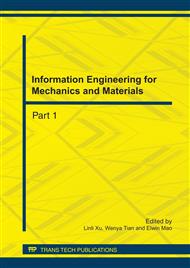[2]
F.Y. Lin, T.S. Lu, Minimum-time trajectory planning based on the shortest path for the wheeled mobile robot , Journal of Harbin Institute of Technology, vol. 13 (2006) 360-363.
Google Scholar
[3]
S. Bazaz, B. Tondu, On-line computing of a robotic manipulator joint trajectory with velocity and acceleration constraints, in Proceedings of the IEEE International Symposium on Assembly and Task Planning, Aug. 1997, pp.1-6.
DOI: 10.1109/isatp.1997.615375
Google Scholar
[4]
Y.K. Choi, Optimal trajectory planning and sliding mode control for robots using evolution strategy, Journal of Robotic Systems, vol. 17 (2000) 423-428.
DOI: 10.1017/s0263574799002118
Google Scholar
[5]
S. Macfarlane, A. Elizabeth, Jerk-bounded manipulator trajectory planning: Design for real-time applications, IEEE Trans Rob Autom , vol. 19, (2003) 42-52.
DOI: 10.1109/tra.2002.807548
Google Scholar
[6]
F. Zhou, Z. Zhang, Path planning for a manipulator based on the decomposition of C space and the roadmap method, Journal of Harbin Engineering University, vol. 30 (2009) 531-535.
Google Scholar
[7]
C.T. Leng, Q.X. Cao, Motion planning for omni-directional mobile robots based on anisotropy and artificial potential field method, Industrial Robot, vol. 36 (2009) 477-488.
DOI: 10.1108/01439910910980204
Google Scholar
[8]
X.R. Xiong, Y.L. Xiong, J - function based geometric reasoning for robotics II: robot motion planning and navigation, in Proceedings of the IEEE International Conference on Systems, Man and Cybernetics, vol. 1, 1995, pp.340-345.
DOI: 10.1109/icsmc.1995.537782
Google Scholar
[9]
M. Alistair, C. Stephen, Virtual springs method: Path planning and collision avoidance for redundant manipulators, International Journal of Robotics Research, vol. 15 (1996) 300-319.
DOI: 10.1177/027836499601500401
Google Scholar
[10]
M. Oda, N. Inaba, Mission design of an in-orbit satellite inspection: Feasibility of the in-orbit satellite servicing, in 11th Annual AAS/AIAA Space Flight Mechanics Meeting, Proceedings, Feb. 2001, pp: 2071-(2085).
Google Scholar
[1]
S.J. Lu, J. Chung, Collision detection enabled weighted path planning: A wrist and base force/torque sensors approach" in 2005 International Conference on Advanced Robotics, ICAR , 05, Proceedings, vol. 2005, Jul. 2005, pp.165-170.
DOI: 10.1109/icar.2005.1507408
Google Scholar
[2]
A. De Luca, A. Alin, Collision detection and safe reaction with the DLR-III lightweight manipulator arm, in IEEE International Conference on Intelligent Robots and Systems, Oct. 2006, pp.1623-1630.
DOI: 10.1109/iros.2006.282053
Google Scholar
[3]
J. Jackson, J. Anthony, Tracking deformable moving objects under severe occlusions, in Proceedings of the IEEE Conference on Decision and Control, vol. 3, 2004, pp.2990-2995.
DOI: 10.1109/cdc.2004.1428922
Google Scholar


